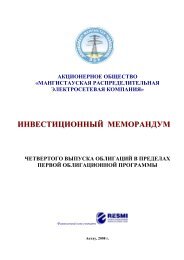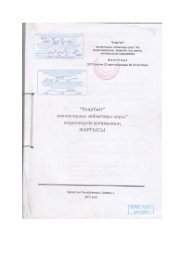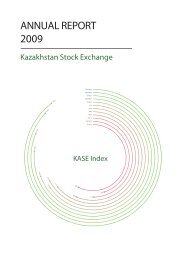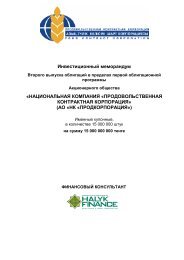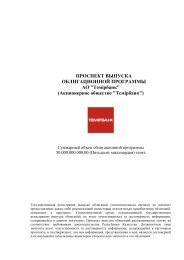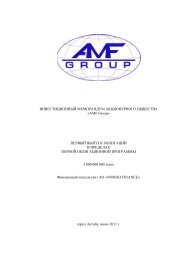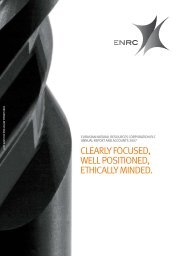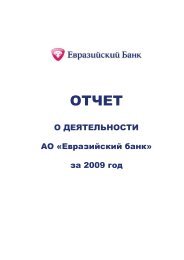JPMorgan - KASE
JPMorgan - KASE
JPMorgan - KASE
Create successful ePaper yourself
Turn your PDF publications into a flip-book with our unique Google optimized e-Paper software.
Domestic Transportation. Oil produced from the Kumkol and South Kumkol fields is transported<br />
east from our Central Processing Facility via a 28 inch lateral pipeline extending 200 kms from the<br />
Kumkol field to Karakoin, Kazakhstan, where this pipeline connects with the Central Pipeline.<br />
The Central Pipeline provides access for our crude oil to the Shymkent refinery. There is also a 20<br />
inch pipeline which runs parallel to the 28 inch pipeline from the Kumkol and South Kumkol<br />
fields to Karakoin. The combined rated capacity for these two lateral pipelines is 350,000 BOPD.<br />
We believe that there is substantial unutilized excess capacity in the Central Pipeline.<br />
Currently, all oil and gas pipelines in Kazakhstan are owned by the Kazakhstani government. We<br />
currently have access to the lateral pipelines and the Central Pipeline under a short-term contract<br />
with KazTransOil, the Kazakhstani national oil transportation corporation, which is renewable by<br />
mutual agreement annually. The contract does not designate specific volumes available to us and<br />
provides for tariff rates established by the Kazakhstaini government. The contract can be<br />
cancelled by either KazTransOil or us on 45 days’ notice. In the HKM acquisition agreement, the<br />
Kazakhstani government agreed to assist us in obtaining commitments for the transportation of<br />
oil through the Central Pipeline.<br />
On October 16, 2002, we received permission from the Kazakhstani government to proceed with<br />
the construction of the 177 km Qyzylkiya Aryskum Maybulak pipeline, or QAM pipeline, connecting<br />
Kumkol to a rail loading station in Dzhusaly via the QAM fields. The QAM pipeline will have an<br />
initial capacity of 100,000 BOPD and is expected to be in full operation by the third quarter of 2003.<br />
KazMunaiGas has the right to participate in the pipeline from Aryskum to Dzhusaly, and<br />
KazTransOil will be the technical operator under a service contract. We estimate the combined cost<br />
of constructing the QAM pipeline and the terminal at Dzhusaly (see “— Transportation to Export<br />
Markets” below) to be approximately $72 million.<br />
Transportation of crude oil to the export market remains our largest single operating cost.<br />
During 2001 and through the first nine months of 2002, the cost of transportation from the<br />
Shymkent loading terminal to Black Sea ports remained relatively constant at approximately $12<br />
per barrel of crude oil. On completion of the QAM pipeline, it is anticipated the cost of this<br />
transportation for crude oil exports will be reduced.<br />
Transportation to Export Markets. Once crude oil arrives at Shymkent from the fields, it is<br />
divided into volumes for export and volumes for refining at Shymkent. Export crude oil barrels<br />
are loaded at the nearby rail terminal of Tekesu onto railcars, to be transported for export west<br />
across Kazakhstan to Atyrau or Aktau, both Kazakhstan ports on the Caspian Sea. From these<br />
ports, there are various routes via pipeline, railroad and tanker for the oil to reach Black Sea<br />
ports and Europe. From Tekesu, crude oil can also be transported by rail east to Druzhba, for<br />
Chinese purchasers, and south to Bukhara (in Uzbekistan), and from there by rail to<br />
Turkmenbashi (a Turkmenistan port on the Caspian Sea) or Aktau, for Europe.<br />
We have entered into swap arrangements with other oil and gas companies, to export crude oil<br />
from the Samara pipeline junction along the Russian Druzhba Export Pipeline System to western<br />
Europe. However, these arrangements are not being utilized and are currently being<br />
renegotiated. In addition, we have the ability to transport our crude oil and refined products to<br />
the Black Sea by rail for export to western Europe. The Shymkent refinery has rail access to<br />
Druzhba rail terminal on the Kazakhstan-Chinese border, where the Kazakhstani rail line<br />
connects with an existing Chinese rail line. In November 1997, we formed Hurricane Dostyk, a<br />
limited liability partnership with Eastern Gate Corporation of Kazakhstan, to construct an oil<br />
trans shipment terminal at Druzhba, which would facilitate exports to western China. The trans<br />
shipment terminal is designed to have a throughput capacity of approximately 20,800 BOPD.<br />
Construction of the terminal was suspended in late 1998. The cost of completion of the terminal<br />
will be funded 100% by us. We will control and operate the facility once it is completed.<br />
Completion of the terminal is planned for 2003 but will be dependent on the development of a<br />
market in and the establishment of long-term contracts with China, and acceptable levels of<br />
transportation tariffs.<br />
78




